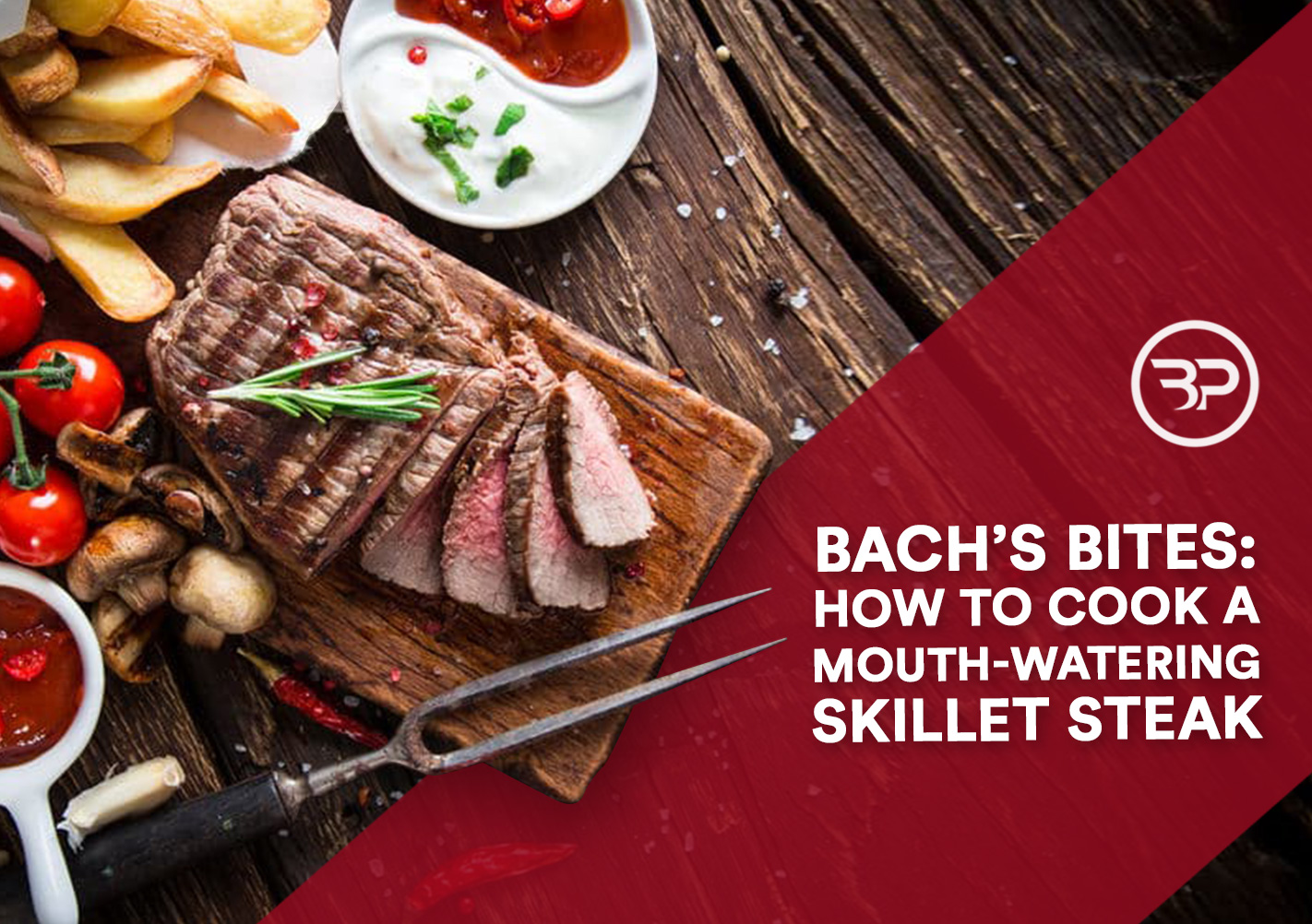Bach’s Bites: How to Cook a Mouth-Watering Skillet Steak
September 25, 2016
Why do most people struggle to get jacked or lean?
In most cases, it’s not an unwillingness to train or a lack of nutrition knowledge.
It’s implementation.
In training, that means actually getting the work down. In nutrition, that means putting down the PopTarts and learning to prepare food that keeps you on track and getting ripped.
And while I understand the convenience and lure of frozen pizza and Kung Pao chicken…
You have to learn how to cook.
It’s part of being a grown-up. That doesn’t mean you should get ready to host Chopped. But every dude should be able to whip up a mouth-watering skillet steak.
MMMM. Steak.
Oh, steak. Nothing tops a well-prepared steak. Beyond channeling your caveman roots, steak is a nutritional powerhouse that supports healthy anabolic hormone levels and hard training. Let’s dig into the nitty-gritty of our beloved steak.
Vitamins and Minerals in Steak
Steak Packs in the B Vitamins
Red meat is high in B-6 and B-12, essential vitamins for a healthy immune and nervous system. Further, red meat packs a punch with niacin– the same stuff in your pre-workout that gives you a “flushing” feeling while aiding in converting carbohydrates into energy.
Despite very dubious #SteakGivesYouCancerAndHeartAttacks claims (driven by suspect correlation-driven research) higher doses of niacin have been used for removing low-density lipoprotein (LDL), or bad cholesterol.
Steak Provides (and Helps You Lift) Iron
Iron’s primary role is the production of hemoglobin and red blood cells. While low iron is rarely an issue for most men, those who eat low protein and vegetarian diets can struggle with fatigue and low energy. Red meat 1-3x per week should keep your iron in a healthy range and boost performance.
Steak for Healthy Hormones
Two of the most vilified nutrients in steak (saturated fat and cholesterol) are essential for healthy testosterone levels.
I’ll cover the red meat safety issue shortly. But first, here’s what I’ve noticed from having coached dozens of vegetarians who added meat back to their diets. They noticed:
- More energy
- Improved sex drive
- Faster ability to build lean muscle
Admittedly, these are anecdotes, not research. But I find them impossible to ignore.
I would speculate that the positive changes could result from an increase in B vitamins and minerals like iron. I’d venture to say it’s also from cholesterol and a subsequent improvement in hormone profiles.
Since cholesterol is a precursor for developing and supporting hormones like testosterone, more dietary cholesterol theoretically provides a bigger foundation for improving testosterone.
This study and study speak to the relationship between cholesterol and testosterone.
And more specifically, to my iron-hoisting brethren, this study shows improvements in testosterone and fat intake to be higher in those who lift. Thus, if you’re training to look better naked and get stronger, skipping red meat may be a misteak. 🙂
Is Red Meat Safe?
To be honest, I’d keep crushing steak regardless of the outcomes. It’s that damn tasty. And I doubt “red meat” is the culprit of many of our food- related health outcomes.
Want to Simplify your Fitness and start making progress today? Click Here.
We could all eat more vegetables, less processed shit, and drink less alcohol. Those are better bets to improving our outcomes than dropping red meat.
But, since the lines are “blurry” on nutritional advice and guidelines for non-registered dieticians, I call upon the slightly more handsome and vastly more intelligent Brad Dieter, PhD and Director of Science Driven Nutrition to chime in:
“The topic of red meat consumption has produced a lot of hyperbole in regard to both the risks and benefits over the past several decades. The claims of red meat being a large contributor to heart disease are largely overstated; however, so are the proposed benefits. It is neither a destroyer of health nor the bee’s knees of being optimally healthy and fit. When you really boil it down and look at the data, red meat can be an excellent addition to a healthy diet as it typically has more vitamins and minerals (e.g. vitamin B12 and iron) than white meat counterparts like chicken. Red meat can be a part of your weekly protein intake along with chicken, pork, fish, and other animal protein sources.”
And if that wasn’t enough, fellow nutrition expert and jacked dude Justin Janoska of NutritionMax filmed this video on the subject:
Basically, the risks and benefits of red meat are both overblown. It won’t turn you into Hercules, and it won’t turn you into a cancer- laden ticking time bomb.
Now let’s get to the important stuff: Making the best damn Cast Iron Steak.
I know what you’re thinking: why not just grill the damn steak?
Has Bach lost his mind…or manhood?
Both are valid points, but let me reason with you. Or, at least give you an excuse. My last two apartments in Denver have had grills, but they aren’t up to par. Maybe I’m being a snob, but a poorly cleaned gas grill used to cook Tofu burgers seems plain wrong to cooking steak on an open flame or charcoal.
It’s like going from a powerhouse gym to being forced to lift at Planet Fitness. Sure, you can do it. But is it worth it?
To make matters worse, grills are also banned on the balconies and patios of my current apartment. Time to get creative.
The Rub
The rub or seasoning is the key to your steak. (Beware, there’s some heat.)
½ cup coarse salt
½ cup coarsely ground black pepper
¼ cup paprika
4 tablespoons pure chili powder
2 tablespoons cayenne pepper
2 tablespoons garlic powder
1 tablespoon cumin
1 tablespoon red pepper flakes
1 tablespoon dried oregano
1 tablespoon dried rosemary
Combine these ingredients in a jar and keep in your fridge. They go well on all types of meat and veggies and will convince your friends you’re a cooking savant.
Want to Simplify your Fitness and start making progress today? Click Here.
The Steak
I prefer a New York Strip but stick to your budget. Here’s a breakdown of your beef cuts.
What about Grass Fed?
Sure, grass-fed is better, but it’s not necessary. And some of the proposed health benefits may be overstated, as covered here.
Preppin’ The Mouth-Watering Skillet Steak
If you want to do it right, start prepping your steak 2-3 hours before your meal. You don’t have to do it this way, but you won’t have to do biceps curls, either. (Some things just shouldn’t be questioned.)
Rinse and Dry
Grab your slab of beef and let it sit at room temperature for 15 minutes. Rinse that bad boy, then pat dry with a paper towel. Getting your steak dry will help your seasonings settle in and improve the sear.
Rub it Down
Lather that slab of meat, baby. Now giggle. You know you want to.
In areas of high marbling, pull the fat away and throw in more seasoning.
If your steak has a strip of fat on the outside, take your steak knife and make a horizontal cut against the fat. Most common in New York Strips, this strip will “curl” around your steak as it’s cooked. Let it breathe!
Fridge or Freezer for 30-45 minutes
I picked this up from Tim Ferriss’ recipe for Sexy Time Steak in The Four Hour Chef. As long as they are not leaky, your fridge or freezer provide dry environments that remove residual moisture. This optimizes the sear on your steak.
Room Temperature and Settle
Generally, getting your meat and poultry close to room temperature will provide a more even cooking environment. If you freeze your steak solid and throw it on the skillet, you’ll pick frozen muscle fibers out of your teeth.
Season your Skillet
Crank your skillet on high, 7-9, and toss in ½ tbls…or a full tbls if you’re feeling frisky… of Grass-Fed butter to coat your skillet. Once the butter melts, sprinkle steak rub on the base of the skillet and toss in your meat.
Note: What’s up with the butter? Obviously, you’ll need to dial back your fat intake for the rest of the day. But, this helps lock in the flavor and aids a better sear when cooking with a cast iron skillet.
Sear
The sear locks in the flavor of the steak by providing a “dense,” protective layer around the rest of the meat. This happens via the Maillard reaction when amino acids and sugars caramelize to change the color and taste of your meat.
With the heat on high, sear each side of the steak for 1-2 minutes, depending on your preference. Before flipping, add another 1/2 -1 tbsp to butter if your skillet is dry.
Flip
Dial the heat back to 5-6 or moderate heat and cook for four minutes. Flip that slab with tongs.
Don’t be a rookie and stab the heart of your steak with a fork.
Flip Again
Use your tongs and cook for four minutes.
Pull it off and Settle.
Ever notice when you cut into any dead animal flesh how the juices run wild, and soon, you’re eating a piece of rubber?
Anytime you’re cooking meat, pull it off early and let it settle on a cutting board or plate for 3-5 minutes. This allows the juices to redistribute while the meat continues to cook.
When to Eat
Obviously, the higher fat content of your meat, the higher calories. Therefore, dial back in other areas during the day and follow a low-fat approach.
To keep calories in check, I use a carb cycling approach to minimize fat gain and maximize muscle recovery most of the time. Steak fits perfectly on low-carb days.
Pair this bad-boy with a bourbon or red wine if you’re feeling fancy and a side of sauteed spinach or cherry tomatoes. You’ll never look at pan-fried steak the same way again!
Related: Carb Cycling: The Uber Convenient way to Shred Fat and Build Muscle
A final note. Are you part of our private Facebook group yet?
No?
Click here to join us. It’s free. And will help you look better naked 🙂
Our community is focused on simplifying fitness so you build your strongest, leanest, and most athletic body…without all the information overload.
Reference
Sallinen JJ, Pakarinen AA, Ahtainen JJ, Kraemer WWJ, Volek, JJS, Hakkinen KK. Relationship between diet and serum anabolic hormone responses to heavy resistance exercise in men. International Journal of Sports Medicine 2004; 25:627-33.









[…] When in doubt, eat foods that are as close to their natural state as possible. Yes, you can cook your food, but eat a blend of fruits, vegetables, and lean meats in various forms. Shop the perimeter of the store, eat grass-fed and organic when you can, and avoid processed junk. I recommend this mouthwatering steak recipe. […]